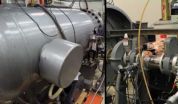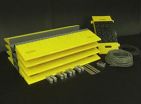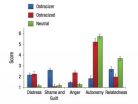(Press-News.org) Human activities are not the primary cause of arsenic found in groundwater in Bangladesh.
Instead, a team of researchers from Lawrence Livermore National Laboratory, Barnard College, Columbia University, University of Dhaka, Desert Research Institute and University of Tennessee found that the arsenic in groundwater in the region is part of a natural process that predates any recent human interaction, such as intensive pumping.
The results appear in the March 4 edition of the Proceedings of the National Academy of Sciences.
Millions of people in Bangladesh and neighboring countries are chronically exposed to arsenic-contaminated groundwater, which causes skin lesions and increases the risk of certain cancers. Bacterial respiration of organic carbon releases naturally-occurring arsenic from sediment into groundwater, but the source of this organic carbon remains unclear.
Brian Mailloux of Barnard College and his team isolated microbial DNA from several depth intervals in arsenic-contaminated aquifers in Bangladesh and analyzed the DNA's radiocarbon signature, which reflects whether the organic carbon used by the microbes derives primarily from younger, surface-derived sources that are transported by groundwater into the aquifers, or older, sediment-derived sources.
Using "bomb pulse" radiocarbon analysis, Lawrence Livermore scientist Bruce Buchholz dated the DNA of groundwater bacteria. He found that the DNA samples were consistently younger than the sediment, suggesting that the microbes favor using surface-derived carbon.
The surface-derived carbon has flowed into the aquifer over hundreds to thousands of years -- a rate that is approximately 100 times slower than groundwater flow. The results suggest that recent human activities, such as intensive groundwater pumping, have not yet significantly affected the release of arsenic into the groundwater at this site.
Above-ground testing of nuclear weapons during the Cold War (1955-1963) caused a surge in global levels of carbon-14 (14C), and remains in all living things. Carbon-14 or radiocarbon is naturally produced by cosmic ray interactions with air and is present at low levels in the atmosphere and food. Although nuclear weapon testing was conducted at only a few locations, excess levels of 14C in the atmosphere rapidly dispersed and equalized around the globe.
According to Buchholz, "The bomb curve forms a chronometer of the past 60 years."
The radiocarbon signature of DNA is a direct measure of the carbon used during microbial respiration and growth. In this study, the team developed a method to filter, extract and purify DNA from groundwater aquifers for radiocarbon analysis to determine the organic carbon pools fueling microbial reduction.
"We were able to separate the recent bomb pulse radiocarbon from the natural carbon signature and found the arsenic levels are now directly tied to a natural process as opposed to being driven by human activities," Buchholz said.
The results may help scientists understand the causes of arsenic contamination in the region, and the development of potential mitigation strategies.
###
Founded in 1952, Lawrence Livermore National Laboratory (http://www.llnl.gov) provides solutions to our nation's most important national security challenges through innovative science, engineering and technology. Lawrence Livermore National Laboratory is managed by Lawrence Livermore National Security, LLC for the U.S. Department of Energy's National Nuclear Security Administration.
END
(Boston) – Researchers at Boston University School of Medicine (BUSM) and VA Boston Healthcare System (VA BHS) have found that cognitive behavioral therapy (CBT) can help relieve pain for people with painful diabetic neuropathies. The study, which is the first of its kind to examine this treatment for people with type II diabetes mellitus, is published in the March issue of the Journal of Pain.
Type II diabetes mellitus is the most common form of the disease and affects more than 20 million Americans. The onset of type II diabetes mellitus is often gradual, occurring ...
CAMBRIDGE, MA -- Since the mid-1800s, doctors have used drugs to induce general anesthesia in patients undergoing surgery. Despite their widespread use, little is known about how these drugs create such a profound loss of consciousness.
In a new study that tracked brain activity in human volunteers over a two-hour period as they lost and regained consciousness, researchers from MIT and Massachusetts General Hospital (MGH) have identified distinctive brain patterns associated with different stages of general anesthesia. The findings shed light on how one commonly used ...
VIDEO:
NASA scientists at the Goddard Cosmic Ice Lab are studying a kind of chemistry almost never found on Earth. The extreme cold, hard vacuum, and high radiation environment of space...
Click here for more information.
Behind locked doors, in a lab built like a bomb shelter, Perry Gerakines makes something ordinary yet truly alien: ice. This isn't the ice of snowflakes or ice cubes. No, this ice needs such intense cold and low pressure to form that the right conditions ...
Back in 2010, the ideas behind a squid's sticky tendrils and Spiderman's super-strong webbing were combined to create a prototype for the first remote device able to stop vehicles in their tracks: the Safe, Quick, Undercarriage Immobilization Device (SQUID). At the push of a button, spiked arms shot out and entangled in a car's axles—bringing a racing vehicle to a screeching halt.*
The need to stop vehicles remotely was identified by the law enforcement community. With funding from Homeland Security's Science & Technology Directorate, and the expertise of the engineers ...
SEATTLE—Researchers used electronic health records to identify Group Health patients who weren't screened regularly for cancer of the colon and rectum—and to encourage them to be screened. This centralized, automated approach doubled these patients' rates of on-time screening—and saved health costs—over two years. The March 5 Annals of Internal Medicine published the randomized controlled trial.
"Screening for colorectal cancer can save lives, by finding cancer early—and even by detecting polyps before cancer starts," said study leader Beverly B. Green, MD, MPH. "But ...
Studied for decades for their essential role in making proteins within cells, several amino acids known as tRNA synthetases were recently found to have an unexpected – and critical – additional role in cancer metastasis in a study conducted collaboratively in the labs of Karen Lounsbury, Ph.D., University of Vermont professor of pharmacology, and Christopher Francklyn, Ph.D., UVM professor of biochemistry. The group determined that threonyl tRNA synthetase (TARS) leads a "double life," functioning as a critical factor regulating a pathway used by invasive cancers to induce ...
VANCOUVER, Wash.—Fishers near marine protected areas end up traveling farther to catch fish but maintain their social and economic well-being, according to a study by fisheries scientists at Washington State University and in Hawaii.
The study, reported in the journal Biological Conservation, is one of the first to look closely at how protected areas in small nearshore fisheries can affect where fishers operate on the ocean and, as a consequence, their livelihood.
"Where MPAs are located in relation to how fishers operate on the seascape is critical to understand for ...
If you think giving someone the cold shoulder inflicts pain only on them, beware. A new study shows that individuals who deliberately shun another person are equally distressed by the experience.
"In real life and in academic studies, we tend to focus on the harm done to victims in cases of social aggression," says co-author Richard Ryan, professor of clinical and social psychology at the University of Rochester. "This study shows that when people bend to pressure to exclude others, they also pay a steep personal cost. Their distress is different from the person excluded, ...
Domestic violence in New Jersey
Article provided by Keith, Winters & Wenning, L.L.C.
Visit us at http://www.kwwlawfirm.com
Everyone thought the story was over. In 2009 pop sensation Rihanna was brutally assaulted by her then boyfriend Chris Brown. The singer stated that she ended the relationship and the media applauded her brave move. She became a role model for domestic violence victims around the world.
That is, until January of 2013 when the star publicly announced that she had rekindled her relationship with her convicted abuser. Unfortunately, Rihanna's ...
Revocable living trust: Is it right for you?
Article provided by Anderson and Associates, P.C.
Visit us at http://www.davidandersonlaw.com/
Most people consider wills for estate planning; however, this is not the only option. In addition to avoiding probate, a revocable living trust may offer you significant before-death and after-death advantages.
In general, a trust involves three parties: the creator, the trustee or trustees (who agree to manage the assets according to the terms of the trust) and the beneficiary or beneficiaries. Something as miniscule as ...



